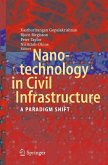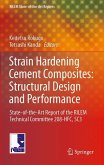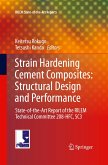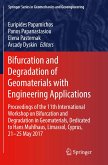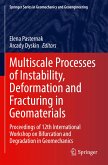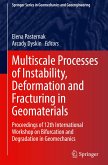Design and Analysis of Composites
Proceedings of the American Society for Composites 39th Technical Conference, Volume 1
Herausgegeben:Zobeiry, Navid; Liu, Xin
Design and Analysis of Composites
Proceedings of the American Society for Composites 39th Technical Conference, Volume 1
Herausgegeben:Zobeiry, Navid; Liu, Xin
- Gebundenes Buch
- Merkliste
- Auf die Merkliste
- Bewerten Bewerten
- Teilen
- Produkt teilen
- Produkterinnerung
- Produkterinnerung
This book presents the proceedings of the American Society for Composites 39th Technical Conference. This volume, the first of six volumes, is a concise collection of cutting-edge research focusing on Artificial Intelligence (AI), Machine Learning (ML), Uncertainty Quantification (UQ), architected composites, and advanced design and manufacturing in composite materials. The volume presents innovative applications such as predictive modeling of composite failures using AI and ML, developing architected composites like auxetic materials and nanocomposites, and exploring advanced manufacturing…mehr
Andere Kunden interessierten sich auch für
![Nanotechnology in Civil Infrastructure Nanotechnology in Civil Infrastructure]() Nanotechnology in Civil Infrastructure77,99 €
Nanotechnology in Civil Infrastructure77,99 €![Strain Hardening Cement Composites: Structural Design and Performance Strain Hardening Cement Composites: Structural Design and Performance]() Kanakubo ToshiyukiStrain Hardening Cement Composites: Structural Design and Performance75,99 €
Kanakubo ToshiyukiStrain Hardening Cement Composites: Structural Design and Performance75,99 €![Strain Hardening Cement Composites: Structural Design and Performance Strain Hardening Cement Composites: Structural Design and Performance]() Kanakubo ToshiyukiStrain Hardening Cement Composites: Structural Design and Performance75,99 €
Kanakubo ToshiyukiStrain Hardening Cement Composites: Structural Design and Performance75,99 €![Bifurcation and Degradation of Geomaterials with Engineering Applications Bifurcation and Degradation of Geomaterials with Engineering Applications]() Bifurcation and Degradation of Geomaterials with Engineering Applications149,99 €
Bifurcation and Degradation of Geomaterials with Engineering Applications149,99 €![Multiscale Processes of Instability, Deformation and Fracturing in Geomaterials Multiscale Processes of Instability, Deformation and Fracturing in Geomaterials]() Multiscale Processes of Instability, Deformation and Fracturing in Geomaterials164,99 €
Multiscale Processes of Instability, Deformation and Fracturing in Geomaterials164,99 €![Multiscale Processes of Instability, Deformation and Fracturing in Geomaterials Multiscale Processes of Instability, Deformation and Fracturing in Geomaterials]() Multiscale Processes of Instability, Deformation and Fracturing in Geomaterials164,99 €
Multiscale Processes of Instability, Deformation and Fracturing in Geomaterials164,99 €![Historic Mortars Historic Mortars]() Historic Mortars112,99 €
Historic Mortars112,99 €-
-
-
This book presents the proceedings of the American Society for Composites 39th Technical Conference. This volume, the first of six volumes, is a concise collection of cutting-edge research focusing on Artificial Intelligence (AI), Machine Learning (ML), Uncertainty Quantification (UQ), architected composites, and advanced design and manufacturing in composite materials. The volume presents innovative applications such as predictive modeling of composite failures using AI and ML, developing architected composites like auxetic materials and nanocomposites, and exploring advanced manufacturing techniques, including additive manufacturing and friction drilling. This collection is valuable for professionals seeking to deepen their understanding of modern composite materials design and analysis approaches. This volume describes the state-of-the-art research on AI/ML for composite design, architected composites, UQ, and advanced manufacturing techniques in composite materials.
Produktdetails
- Produktdetails
- Proceedings of the American Society for Composites Annual Technical Conferences
- Verlag: Springer / Springer Nature Switzerland / Springer, Berlin
- Artikelnr. des Verlages: 89552421, 978-3-032-01729-1
- Seitenzahl: 350
- Erscheinungstermin: 5. Dezember 2025
- Englisch
- Abmessung: 235mm x 155mm
- ISBN-13: 9783032017291
- ISBN-10: 3032017297
- Artikelnr.: 74820398
- Herstellerkennzeichnung
- Springer-Verlag GmbH
- Tiergartenstr. 17
- 69121 Heidelberg
- ProductSafety@springernature.com
- Proceedings of the American Society for Composites Annual Technical Conferences
- Verlag: Springer / Springer Nature Switzerland / Springer, Berlin
- Artikelnr. des Verlages: 89552421, 978-3-032-01729-1
- Seitenzahl: 350
- Erscheinungstermin: 5. Dezember 2025
- Englisch
- Abmessung: 235mm x 155mm
- ISBN-13: 9783032017291
- ISBN-10: 3032017297
- Artikelnr.: 74820398
- Herstellerkennzeichnung
- Springer-Verlag GmbH
- Tiergartenstr. 17
- 69121 Heidelberg
- ProductSafety@springernature.com
Navid Zobeiry is an associate professor in the Materials Science and Engineering department at the University of Washington, with an adjunct position in the Aeronautics and Astronautics department. His research focuses on the intersection of materials science, data science, and advanced manufacturing. Xin Liu is an Assistant Professor in the Mechanical and Aerospace Department at the University of Texas at Arlington (UTA). He is also a member of the Institute for Predictive Performance Methodologies at the UTA Research Institute. His research focuses on machine learning-assisted multiscale modeling, composite materials and structures, and lattice metamaterials.
Part 1: AI and ML in Composites.- Chapter 1: A Machine Learning Approach for Predicting Bending After Impact Strength and Failure Modes in Hybrid (CFRP/GFRP) Sandwich Composites.- Chapter 2: Deep Learning Models for Automatic Image Segmentation of Low Velocity Impact Damage in CFRP Composites.- Chapter 3: Developing Continuum Damage Model Tensors for Ceramic Matrix Composites Using Genetic Programming Based Symbolic Regression.- Chapter 4: Development of Data-Driven Surrogate Models for Rapid Simulation of Fibre Reinforced Composites in Progressive Fracture Tests.- Chapter 5: Discerning Microstructure of CMC Minicomposites from Micro-CT Imaging Data Using Machine Learning.- Chapter 6: Failure Prediction of Fiber-Reinforced Polymer Composite Materials Using Data-Driven Modeling.- Chapter 7: Image-Based RKPM for Accessing Failure Mechanisms in Composite Materials.- Chapter 8: Implementing Machine Learning Methodologies to Characterize Hidden Damages in Composite Plates Through Lamb Waves.- Chapter 9: Integrated Process and Failure Analysis in Composites Using Multi-Fidelity Simulations and Machine Learning.- Chapter 10: Using Neural Network to Improve Failure Predictions.- Part 2: Architected Composites.- Chapter 11: Additive Manufacturing of Wood Nanocomposites Using Natural Fibers.- Chapter 12: Composite Core Designs for Freeform Structures.- Chapter 13: Development of Auxetic Composite Materials for Improved Impact Properties.- Chapter 14: Failure Mechanism and Energy Absorption Characteristics of Auxetic Pyrolytic Carbon Reinforcements Embedded in Different Matrix Materials.- Chapter 15: Improving Composite Tailorability Through Architected Nacre Tablets.- Chapter 16: Interlaminar Shear Strength of Carbon/Epoxy Laminates Containing Magnetically Aligned Nickel-Coated, Diazotized Carbon Nanotubes.- Part 3: Design and Manufacturing.- Chapter 17: 3D Printing of Woven Carbon Fiber Composites via a Stereolithography-Inspired Technique with Consolidation.- Chapter 18: Abrasive Friction Drilling in Fiber Reinforced Thermosetting Polymer Composites.- Chapter 19: Effect of Fiber Angle on the Radial Stress in Hybrid Aluminum/Composite Tubes.- Chapter 20: Efficient Manufacturing of Carbon Fiber Reinforced EPON-Based Epoxy Resin Composites via Hot Press-Triggered Frontal Polymerization.- Chapter 21: Evaluation of Alumina Particle Reinforced Aluminum Matrix Composites Fabricated by Accumulative Roll Bonding Method.- Chapter 22: Optimal Design of Viscoelastic Laminated Sandwich Composite Structures Considering Thermally-Induced Deformation of Composite Skins Using Lamination Parameters.- Chapter 23: Optimized Design Workflow for Patient-Customized Composite Orthotics.- Chapter 24: Stack Drilling of Carbon Fiber Reinforced Polymer Laminate and Metals Stacks Using Friction Flow Drilling.- Part 4: ICME.- Chapter 25: Molecular Dynamics Investigation of Bonding Structure and Property Relationships at the Interface Between Cellulose Nanocrystals and Glass Fibers.- Part 5: Uncertainty Quantification.- Chapter 26: Bayesian Calibration and Uncertainty Quantification of Cohesive Zone Parameters at an Adhesively Bonded Textile and Fabric Interface.- Chapter 27: Efficient Design of Laminate Composites Using Ensemble Kalman Inversion Method.- Chapter 28: Reliability-Based Design and Certification of Hybrid Composites.- Chapter 29: Uncertainty Quantification in Advanced Aerospace Composite Manufacturing Through Stochastic Finite Element Analysis and Probabilistic Machine Learning.
Part 1: AI and ML in Composites.- Chapter 1: A Machine Learning Approach for Predicting Bending After Impact Strength and Failure Modes in Hybrid (CFRP/GFRP) Sandwich Composites.- Chapter 2: Deep Learning Models for Automatic Image Segmentation of Low Velocity Impact Damage in CFRP Composites.- Chapter 3: Developing Continuum Damage Model Tensors for Ceramic Matrix Composites Using Genetic Programming Based Symbolic Regression.- Chapter 4: Development of Data-Driven Surrogate Models for Rapid Simulation of Fibre Reinforced Composites in Progressive Fracture Tests.- Chapter 5: Discerning Microstructure of CMC Minicomposites from Micro-CT Imaging Data Using Machine Learning.- Chapter 6: Failure Prediction of Fiber-Reinforced Polymer Composite Materials Using Data-Driven Modeling.- Chapter 7: Image-Based RKPM for Accessing Failure Mechanisms in Composite Materials.- Chapter 8: Implementing Machine Learning Methodologies to Characterize Hidden Damages in Composite Plates Through Lamb Waves.- Chapter 9: Integrated Process and Failure Analysis in Composites Using Multi-Fidelity Simulations and Machine Learning.- Chapter 10: Using Neural Network to Improve Failure Predictions.- Part 2: Architected Composites.- Chapter 11: Additive Manufacturing of Wood Nanocomposites Using Natural Fibers.- Chapter 12: Composite Core Designs for Freeform Structures.- Chapter 13: Development of Auxetic Composite Materials for Improved Impact Properties.- Chapter 14: Failure Mechanism and Energy Absorption Characteristics of Auxetic Pyrolytic Carbon Reinforcements Embedded in Different Matrix Materials.- Chapter 15: Improving Composite Tailorability Through Architected Nacre Tablets.- Chapter 16: Interlaminar Shear Strength of Carbon/Epoxy Laminates Containing Magnetically Aligned Nickel-Coated, Diazotized Carbon Nanotubes.- Part 3: Design and Manufacturing.- Chapter 17: 3D Printing of Woven Carbon Fiber Composites via a Stereolithography-Inspired Technique with Consolidation.- Chapter 18: Abrasive Friction Drilling in Fiber Reinforced Thermosetting Polymer Composites.- Chapter 19: Effect of Fiber Angle on the Radial Stress in Hybrid Aluminum/Composite Tubes.- Chapter 20: Efficient Manufacturing of Carbon Fiber Reinforced EPON-Based Epoxy Resin Composites via Hot Press-Triggered Frontal Polymerization.- Chapter 21: Evaluation of Alumina Particle Reinforced Aluminum Matrix Composites Fabricated by Accumulative Roll Bonding Method.- Chapter 22: Optimal Design of Viscoelastic Laminated Sandwich Composite Structures Considering Thermally-Induced Deformation of Composite Skins Using Lamination Parameters.- Chapter 23: Optimized Design Workflow for Patient-Customized Composite Orthotics.- Chapter 24: Stack Drilling of Carbon Fiber Reinforced Polymer Laminate and Metals Stacks Using Friction Flow Drilling.- Part 4: ICME.- Chapter 25: Molecular Dynamics Investigation of Bonding Structure and Property Relationships at the Interface Between Cellulose Nanocrystals and Glass Fibers.- Part 5: Uncertainty Quantification.- Chapter 26: Bayesian Calibration and Uncertainty Quantification of Cohesive Zone Parameters at an Adhesively Bonded Textile and Fabric Interface.- Chapter 27: Efficient Design of Laminate Composites Using Ensemble Kalman Inversion Method.- Chapter 28: Reliability-Based Design and Certification of Hybrid Composites.- Chapter 29: Uncertainty Quantification in Advanced Aerospace Composite Manufacturing Through Stochastic Finite Element Analysis and Probabilistic Machine Learning.


